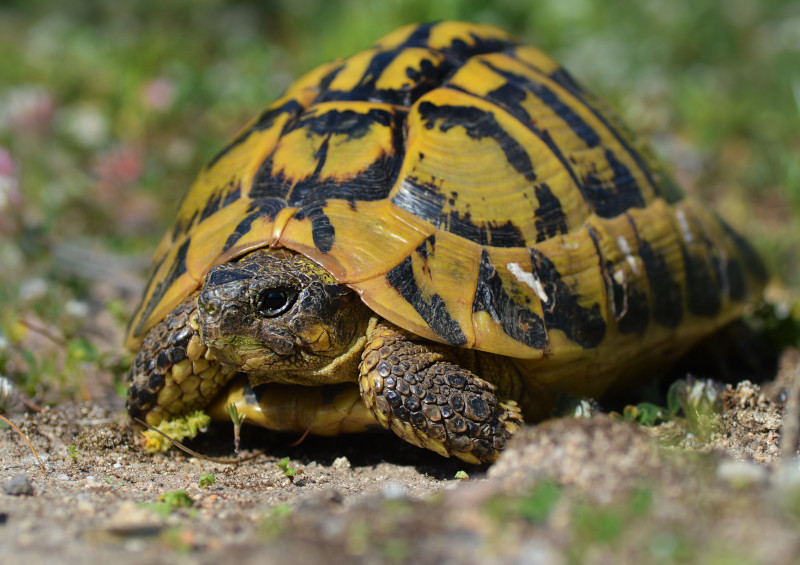
Hermann’s Tortoise Facts
- This marvelous creation of time and evolution most frequently goes by the somewhat confusing common name of the Hermann’s Tortoise. For the moment, the reptile has no other broadly accepted general title. That’s not that uncommon, though.
- The moniker does generate a small degree of confusion, however. That’s because two subspecies of the tortoise exist. These bear the designations of western hermann’s tortoise and eastern hermann’s tortoise. Yet, both commonly go by the one name.
- Within the scientific community, though, the primary species most likely remains better known by its technical tag. Thankfully, that’s a simple term for the layperson to pronounce. That’s due to the fact that it holds the formal epithet Testudo hermanni.
- The creature received that designation due to the efforts of Johann Friedrich Gmelin. The German herpetologist accomplished the first recognition of the animal as a separate and distinct species. That scientifically noteworthy deed occurred in 1789.
- Sadly, the remarkable Hermann’s Tortoise appears to be declining in numbers in the wild. That most unfortunate state further seems to hold true throughout its entire native range. The IUCN therefore lists the reptile as Near Threatened on its Red List.
- The intriguing animal faces multiple threats to its continued existence as a species. Not surprisingly, though, most of these dangers stem from the actions of mankind. They include the related peril of habitat loss and the ongoing effects of climate change.
Related Articles




Hermann’s Tortoise Physical Description
The remarkable Hermann’s Tortoise generally captures the attention and piques the interest of those who encounter it. Yet, the animal typically does so due more to its charming appearance than size. That’s true since it only ranks as small-to-medium sized tortoise.
Like the majority of its relations, it also displays a certain degree of the physiological characteristic known as sexual dimorphism. In its specific case, though, this has nothing to do with size. The natural trait manifests itself in terms of differences in physical structure.
This holds true partly due to the fact that the shell on the underside of the male holds a different design than that of the female. It grows as more concave in design. Its tail also develops differently. This appendage grows longer and thicker than that of the female.
Of the two known subspecies, the eastern one achieves a much greater average size than does the other. Mature adults of that division attain shell lengths of up to 11 in (28 cm). Their mean weights also vary accordingly. This typically ranges from 6.6 – 8.8 lb (3 – 4 kg).
Meanwhile, the western variety of the species reaches significantly smaller measurements. For this group, individuals rarely exceed 7.1 in (18 cm) in length of shell. Indeed, most remain much smaller. Some mature adults do not grow beyond 2.8 in (7 cm) long.
Otherwise, however, both subgroups and the two genders of the Hermann’s Tortoise display the same overall apperance. The carapace presents a dome shape, with strongly yellow-orange shades. Large, bold black markings additionally dot the shell in random patterns.
The head itself, though, usually presents as either brown or black. Yet, sometimes both appear. A small yellow spots also shows on each side of the head. Its upper jaw has a slight hook to it, with a horny beak. The legs are scaly, brown or grayish, and with yellow markings.
- Kingdom: Animalia
- Phylum: Chordata
- Class: Reptilia
- Order: Testudines
- Family: Testudinidae
- Genus: Testudo
- Species: T. hermanni

Hermann’s Tortoise Distribution, Habitat, and Ecology
The reptilian wonder named the Hermann’s Tortoise evolved as native to a moderate expanse of the earth’s surface. The location and extent of that zone of habitation might surprise some people, though. That’s because the animal developed as native to Europe.
Yet, even there the animal only resides in certain areas. The subgroups further complicate this by having their own separate habitat ranges. The western member appears in the southern regions. The eastern one, however, lives in the southeastern part of the continent.
Taken collectively, though, the awesome tortoise inhabits a large section of the area. The western subspecies lives in such countries as France, Spain, and Italy. The eastern subgroup, however, appears in such countries as Serbia, Albania, Greece, and Turkey.
The beautiful tortoise, like so many of its kind, displays strong preferences for its choice of habitat. As a general principle, individuals make their home in one of two ecosystems. These usually consist of either deciduous forests, such as oak and beech, or meadows.
The Hermann’s Tortoise takes shelter at night, usually consist of hollow regions under hedges or thick bushes. During this period, they hunt for their food. At roughly midday, the sun becomes too hot for them, and they return to their shelter, until mid afternoon.
In keeping with the pattern established by its relatives, it evolved as herbivorous in nature. In its case, its diet includes a wide variety of locally available flora. The reptile appears to to make its selection base on scent. Flowers thus comprise a large percentage of its food.
The creature also usually hibernates through the winter. Around late February, though, it emerges. Soon after, it mates. Females tend to lay between 2 – 12 eggs per clutch. These she deposits into a small nest dug into the soil. Incubation generally requires about 90 days.
Species Sharing Its Range



Check out our other articles on 7 Intriguing South Carolina Insects, Moose, Waw an Namus, Appalachian Avens, Vietnamese Mossy Frog, East African Lowland Honey Bee, Black Mamba









Leave a Reply